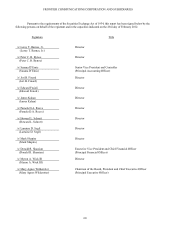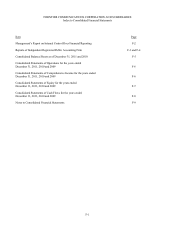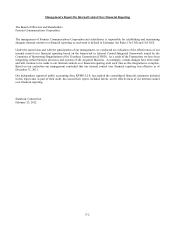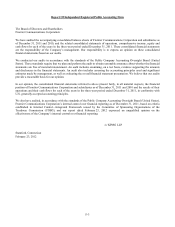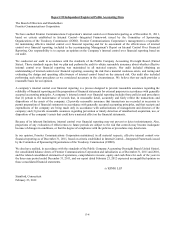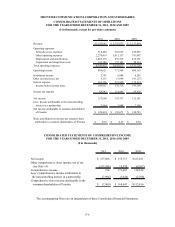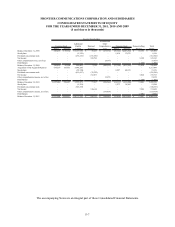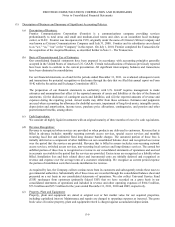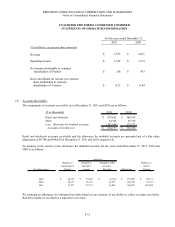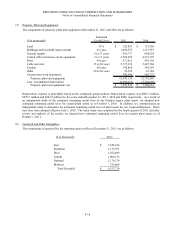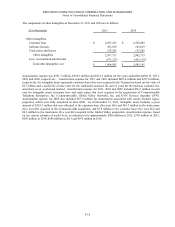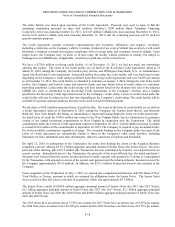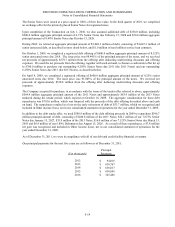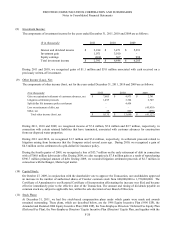Frontier Communications 2011 Annual Report Download - page 73
Download and view the complete annual report
Please find page 73 of the 2011 Frontier Communications annual report below. You can navigate through the pages in the report by either clicking on the pages listed below, or by using the keyword search tool below to find specific information within the annual report.
FRONTIER COMMUNICATIONS CORPORATION AND SUBSIDIARIES
Notes to Consolidated Financial Statements
F-10
(f) Goodwill and Other Intangibles:
Intangibles represent the excess of purchase price over the fair value of identifiable tangible net assets acquired.
We undertake studies to determine the fair values of assets and liabilities acquired and allocate purchase prices to
assets and liabilities, including property, plant and equipment, goodwill and other identifiable intangibles. We
annually (during the fourth quarter) or more frequently, if appropriate, examine the carrying value of our
goodwill and trade name to determine whether there are any impairment losses. We test for goodwill impairment
at the “operating segment” level, as that term is defined in U.S. GAAP. Effective with the third quarter of 2011,
the Company reorganized into six operating segments in order to leverage the full benefits of its local
engagement model. The six operating segments consist of the following regions: National, Northeast, Southeast,
Central, Midwest and West. Our operating segments are aggregated into one reportable segment. In conjunction
with the reorganization of our operating segments effective with the third quarter of 2011, we reassigned
goodwill to our reporting units using a relative fair value allocation approach.
The Company amortizes intangible assets with estimated useful lives over those lives and reviews such intangible
assets at least annually to assess whether any potential impairment exists and whether factors exist that would
necessitate a change in useful life and a different amortization period.
(g) Impairment of Long-Lived Assets and Long-Lived Assets to Be Disposed Of:
We review long-lived assets to be held and used and long-lived assets to be disposed of, including customer lists,
for impairment whenever events or changes in circumstances indicate that the carrying amount of such assets
may not be recoverable. Recoverability of assets to be held and used is measured by comparing the carrying
amount of the asset to the future undiscounted net cash flows expected to be generated by the asset.
Recoverability of assets held for sale is measured by comparing the carrying amount of the assets to their
estimated fair market value. If any assets are considered to be impaired, the impairment is measured by the
amount by which the carrying amount of the assets exceeds the estimated fair value. Also, we periodically assess
the useful lives of our tangible and intangible assets to determine whether any changes are required.
(h) Derivative Instruments and Hedging Activities:
We account for derivative instruments and hedging activities in accordance with U.S. GAAP which requires that
all derivative instruments, such as interest rate swaps, be recognized in the financial statements and measured at
fair value regardless of the purpose or intent of holding them.
(i) Investments:
Investments in entities that we do not control, but where we have the ability to exercise significant influence over
operating and financial policies, are accounted for using the equity method of accounting.
(j) Income Taxes and Deferred Income Taxes:
We file a consolidated federal income tax return. We utilize the asset and liability method of accounting for
income taxes. Under the asset and liability method, deferred income taxes are recorded for the tax effect of
temporary differences between the financial statement basis and the tax basis of assets and liabilities using tax
rates expected to be in effect when the temporary differences are expected to reverse.
(k) Stock Plans:
We have various stock-based compensation plans. Awards under these plans are granted to eligible officers,
management employees, non-management employees and non-employee directors. Awards may be made in the
form of incentive stock options, non-qualified stock options, stock appreciation rights, restricted stock, restricted
stock units or other stock-based awards. We have no awards with market or performance conditions. Our general
policy is to issue shares from treasury upon the grant of restricted shares and the exercise of options.
The compensation cost recognized is based on awards ultimately expected to vest. U.S. GAAP requires
forfeitures to be estimated and revised, if necessary, in subsequent periods if actual forfeitures differ from those
estimates.
(l) Net Income Per Common Share Attributable to Common Shareholders:
Basic net income per common share is computed using the weighted average number of common shares
outstanding during the period being reported on, excluding unvested restricted stock awards. The impact of
dividends paid on unvested restricted stock awards have been deducted in the determination of basic and diluted


